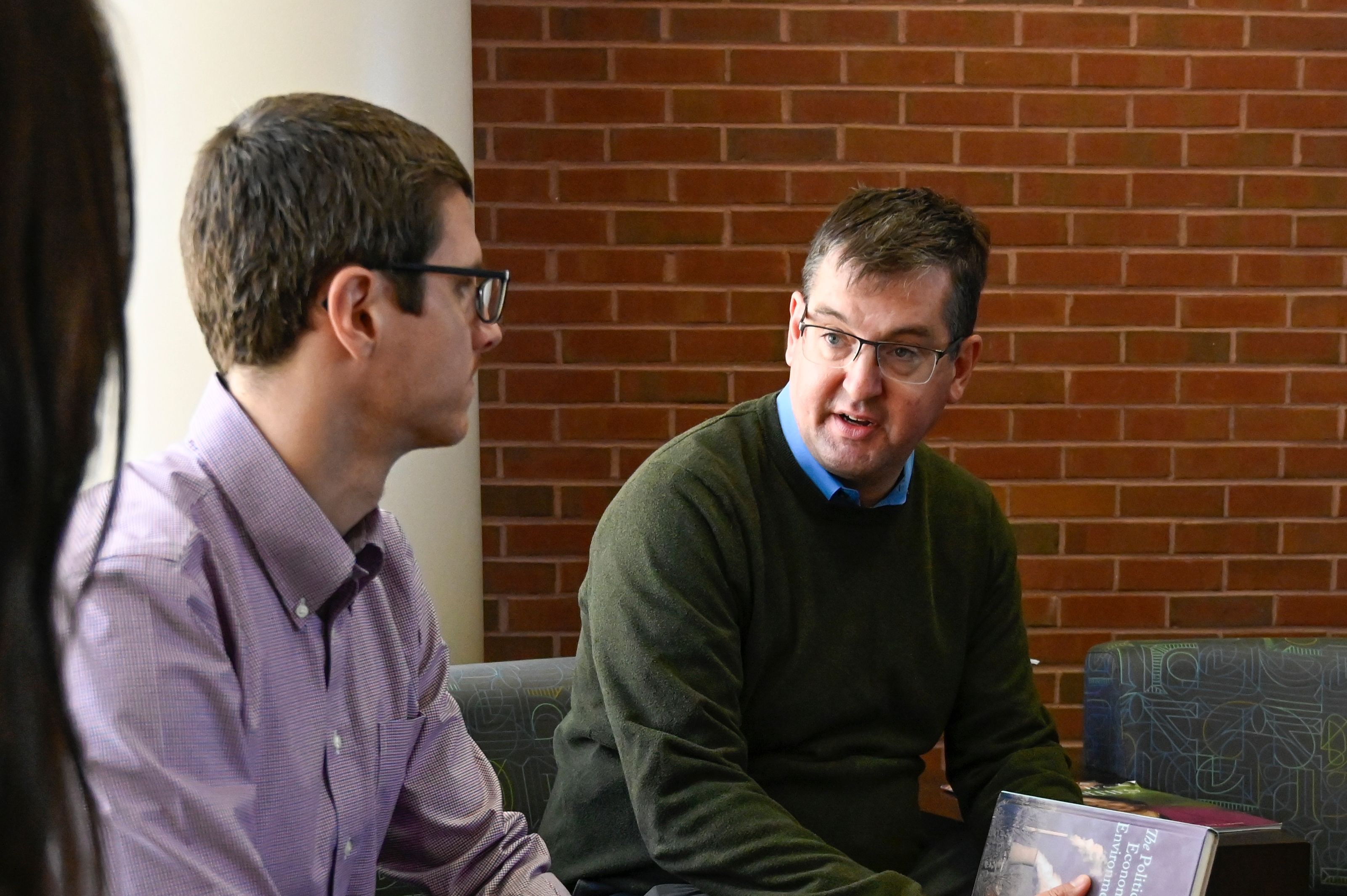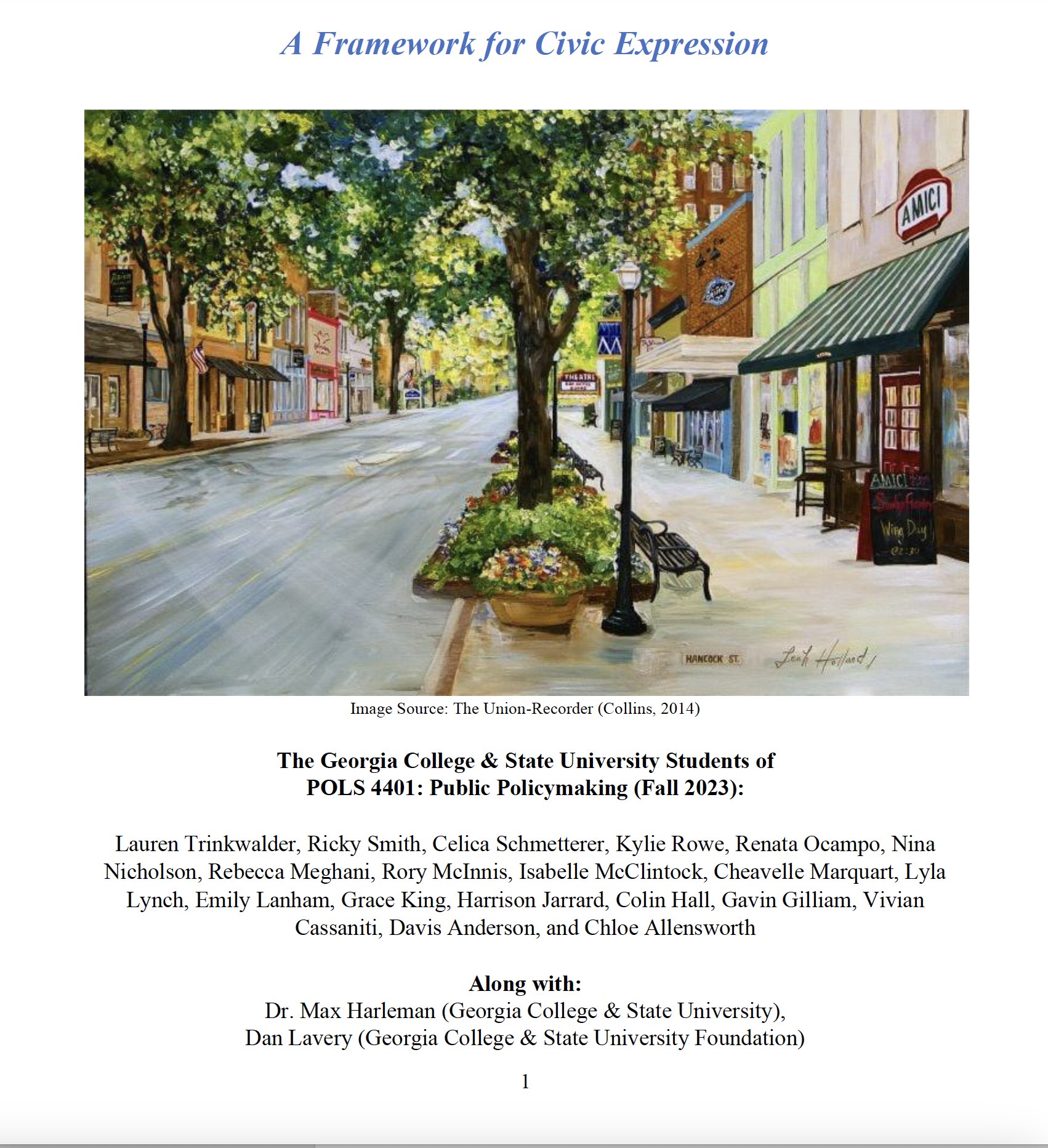GCSU government students create ordinance for public art in Milledgeville
E very once in a while, an obstacle isn’t an obstacle at all.
It’s the perfect opportunity.
That happened last fall when people on campus noticed the city had no public art ordinance. For years, Milledgeville City Council members said they wanted one. Without one, they had no guidelines for approving municipal art.
That void gave a Georgia College & State University policymaking class some real-world experience. By proposing rules for art in the city, that class may also pave the way for future art students to use community space as their palette.

The grant specifies beautification of Milledgeville through public art. But regulations didn’t exist for artistic improvement.
To use the GCSU Foundation grant, Lavery turned to Dr. Max Harleman, assistant professor of public administration who teaches “Public Policymaking.” Harleman had extended the course’s federal scope to include state and local regulatory policymaking.
The town’s need for an ordinance, he said, “just fell into my lap at the right time.”
A draft of the public ordinance awaits approval by the Milledgeville City Council and other community leaders. Once ratified, the student-written policy will immediately advance projects awaiting municipal guidelines.
Milledgeville faced a similar situation about eight years ago, when the Oconee River Greenway Foundation had a grant to install art on public property near the Greenway. The grant required the establishment of an ordinance for additional art projects the foundation wanted to fund.
“Thankfully, all these years later, the public policy class at Georgia College was able to get this over the finish line,” Reynolds said. “I appreciate the efforts of Professor Harleman and his students to advance this much-needed ordinance and look forward to its passage.”
Harleman involved his entire class—19 students—in formulating the new policy. They worked in teams to design legislation, write guidelines and produce an implementation plan. Some cited ways the city would evaluate artwork and prevent deterioration. Others acted as a communications team, creating PowerPoint slides to publicize class ideas.
“The four teams worked in collaboration with each other on the final project, which was the report presented to the city council,” Harleman said. “I think the work was of extremely high quality and so did council members. So, I couldn’t be happier with the outcome. The only better outcome would be to get the ordinance passed and see some public art. That is ultimately what we care most about.”

“Once I got a bite of policy life,” King said, “I was like ‘Sign me up.’ I wanted to learn more about policymaking and, the first day of class, Dr. Harleman said we’d actually work on a public ordinance. I was like, ‘Oh my gosh. This is amazing. It’s gonna be the best course ever.’ I never had a professor do something like this. I was super excited.”
“That students can have an impact that directly changes laws or how things run in government is really awesome,” she said. “To know we helped provide something beneficial to our community makes me happy.”
King first presented the idea to the council in December 2023. She was joined for a formal presentation in January 2024 by Renata Ocampo and Vivian Cassaniti, students who worked on the project before graduating last May.
An article in the Union Recorder relayed how impressed city council members were with the presentation. Several said they couldn’t recall anybody, let alone college students, presenting an idea with a ready-made policy to go with it.
 The ordinance was the culmination of months of work.
The ordinance was the culmination of months of work.
First, the class researched others cities that allow beautification by art, like Athens and Atlanta, Georgia, and Nashville, Tennessee. Through art, residents can show appreciation for their communities and help preserve historic value. Public art can also have economic impact—showcasing a city’s culture in a vibrant way, increasing tourism and enriching life for residents.
The report included measures for public hearings, definitions of what public art is and where jurisdictions lie—“you know, all the nitty-gritty details you don’t really think about,” King said. In broad terms, students defined types of art that can be publicly displayed like sculptures, murals, temporary exhibits and lighting.
To oversee applications for municipal art, students specified the creation of a Milledgeville Public Arts board. They provided guidelines for this board to determine appropriateness, thus ensuring future art in Milledgeville is welcoming, family friendly, non-commercial and not political.
Town organizations and groups have long been interested in using art to “characterize our sense of place and provide creative expression,” according Rebekah Snider, executive director of Visit Milledgeville.
“It quickly became clear that our community was searching for a roadmap, proven success stories and a process for how we begin to welcome and activate public art while also maintaining a balance between Milledgeville’s historic assets and artistic expression,” Snider said.
“The drafted ordinance helped us to address a clear process for incorporating public art into the city—ensuring its long-term sustainability and effectiveness,” she added. “We eagerly anticipate the uniqueness it will add to our neighborhoods and the expansion of our community identity. We are incredibly grateful to Georgia College and specifically Dr. Max Harleman and Ashley Copeland for their support of our passion and vision for what the future may hold concerning creative placemaking. We believe that the best is yet to come.”
The ordinance isn’t the first community-based engagement project to come out of Georgia College’s Department of Government and Sociology, Harleman said. But it’s the first university project involving policy written by students that may soon become regulatory law.
Knowing it might also create a way for future residents and art students to paint public murals makes the work even more gratifying, King said.
Taking Harleman’s course solidified her desire for a career in government. She plans to get a master’s in public administration, then work as a policymaker or lobbyist.
